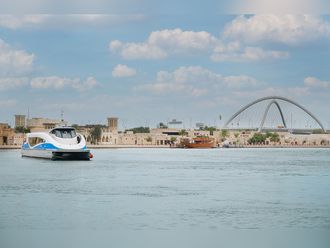Art lovers know Auver-sur-Oise, a village North of Paris, as the backdrop of Vincent Van Gogh's most famous paintings. The French anti-terrorist police, however, see the village as the nerve centre of the Mujahideen Khalq, an Islamic-Marxist sect of Iranian origin with branches in some 100 countries across the globe.
Last Tuesday, the picturesque village was encircled by heavily armed French anti-terrorist troops, backed by helicopter gunships. In scenes out of a war movie, French special forces raided some 40 houses in the village and rounded up more than 150 members of the sect.
Among those arrested was Maryam Rajavi, a 50-year-old former guerrilla fighter, whose ex-husband, Massoud Rajavi, is the "Supreme Guide" of the sect.
"The group was creating a terrorist base north of Paris," said Jean-Louis Bruguiere, the French judge in charge of counter-terrorism.
Terrorist organisation
Better known by its acronym of MEK, the group has been trying to topple the Iranian regime since it broke with the revolutionaries there in 1981. The sect was classified as a terrorist organisation by U.S. President Bill Clinton in 1997 as part of his forlorn attempt at fence-mending with the ruling mullahs of Tehran.
Last year, the European Union, yielding to pressure from Washington, put the MEK on its list of terrorist groups. The Auver-sur-Oise raids were the latest in a series of setbacks that the MEK has suffered this year.
In April, the U.S.-led forces that liberated Iraq captured 20 bases used by the MEK for operations against Iran. Now the MEK has lost its oldest sanctuary. France was the most consistent supporter of the MEK for almost a quarter of a century.
Rajavi fled from Tehran to Paris in 1981 by hijacking an Iranian passenger aircraft. Among those he brought with him was Abol-Hassan Bani-Sadr, the first president of the Islamic Republic who had just broken with Ayatollah Khomeini. Claude Cheysson, then France's foreign minister, visited the two men and persuaded them to work with Iraq, then engaged in a war against Iran, to topple the Khomeini regime.
At a meeting arranged by Cheysson, Rajavi and the then Iraqi Foreign Minister, Tariq Aziz, signed a memorandum of understanding under which the MEK would receive financial and political support from Baghdad in exchange for helping the Iraqi war effort against Iran.
Between 1982 and 1985 Rajavi visited Baghdad on six occasions and developed a personal relationship with Saddam Hussain. The Iraqi leader helped the group set up a number of camps inside Iraq to train Iranians for sabotage.
The MEK was founded in 1965, and its ideology emerged as a mixture of Islam and Marxism. Throughout the 1960s and much of the 1970s, the MEK, with help from the KGB, engaged in a campaign against the Shah, and sent its supporters to Cuba, East Germany and South Yemen to train in guerrilla tactics. Many MEK guerrillas were also trained in Palestinian camps in Lebanon.
MEK also helped Moscow to eliminate U.S. influence in Iran. In 1970 and 1971 MEK assassins murdered five American military technicians working with the Iranian armed forces. In Iran's 1978-79 revolutionary turmoil the MEK played an active role in helping Khomeini come to power.
MEK hit squads burnt scores of cinemas, restaurants, hotels and bookshops. Within a year, however, the MEK decided that the Khomeinist regime was not revolutionary enough and had to be toppled.
Support for the MEK remained a bipartisan policy of France until this week. In 1987, President Jaques Chirac, then prime minister, signed an accord with the MEK, granting it protection in exchange for a promise not to kill Iranian officials on French soil.
The MEK, now a hermetic personality cult built around blind devotion to Rajavi, has recruited its adepts mainly from among the relatives of people executed by the Khomeinist regime. Individual members are subjected to months of intense brainwashing.
They are not allowed to develop any normal relationship with anyone outside the organisation. In Iraq, by 1988 the MEK had created a fighting force of some 10,000. The force helped Saddam Hussain in his genocidal campaign against Kurds.
Crimes against humanity
In 1991 they also helped Saddam crush the Iraqi Shiites revolt in the south. Today, many Iraqi Kurds and Shiites want the MEK leaders to be tried on charges of crimes against humanity. The MEK also has a support base in the U.S. Congress.
Even so, there is little possibility of the U.S. accepting the services of an organisation that it classifies as "terrorist".
The French, however, seem to have additional reasons. With Saddam gone, France has no friends left in the Middle East and seems to have decided to score points with Tehran by dismantling the MEK. That may well encourage the mullahs to warm up to France, especially as the prospect of a direct clash with the U.S. begins to take shape.
The writer, an Iranian author and journalist, is based in Europe. He can be contacted at amirtaheri@benadorassociates.com
Amir Taheri: France paints an abstract picture to please Iran
Art lovers know Auver-sur-Oise, a village North of Paris, as the backdrop of Vincent Van Gogh's most famous paintings.










